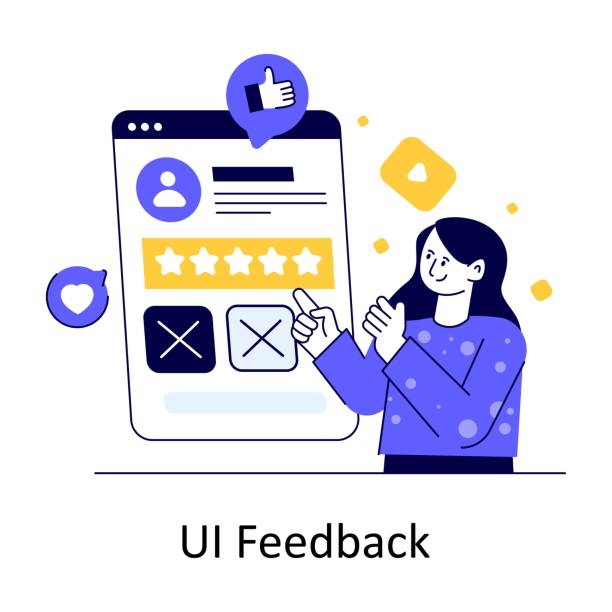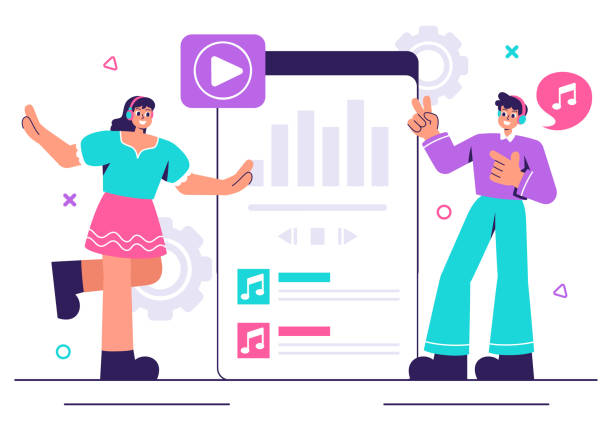Introduction to Responsive Web Design and Its Critical Importance

In today’s world, where users access the internet from countless devices, from small smartphones to large smart TVs, #Responsive_Web_Design has become an undeniable necessity.
One can no longer expect success and effective audience engagement by designing a fixed website that only looks good on desktop computer screens.
Responsive website design is an approach that enables websites to intelligently and fluidly adapt to the screen size and orientation of the device the user is using.
This means that a responsive website automatically adjusts its layout, image dimensions, and font sizes to provide an optimal and flawless user experience, whether on desktop computers, tablets, or smartphones.
This advanced approach offers numerous benefits not only for end-users seeking ease of access but also for businesses and developers.
From an educational perspective, a deep understanding of this concept is vital for every modern web developer, UX/UI designer, and even business owners to ensure a strong and effective presence in the digital space.
In the past, many organizations designed separate versions of their websites for desktop and mobile, but this method was costly, time-consuming, and very difficult to maintain.
Responsive web design solves this problem by providing a single, unified codebase that works correctly across all devices without the need for multiple versions.
This leads to significant optimization in resources, development time, and maintenance costs.
The importance of this type of design becomes even more evident when we consider that a large portion of web traffic currently comes from mobile devices, and this upward trend continues.
Therefore, if your website is not properly responsive, you will effectively lose a large portion of your potential audience and provide them with a poor user experience, which will lead to users abandoning the site.
This issue, especially in today’s competitive markets, can mean the difference between the failure or success of a business and create a significant distinction between you and your competitors.
Does your company’s website create a professional and lasting first impression on potential customers? Rasawb, with its professional corporate website design, not only reflects your brand’s credibility but also paves the way for your business growth.
✅ Building a powerful and trustworthy brand image
✅ Attracting target customers and increasing sales
⚡ Get free consultation
Why Responsive Web Design is a Necessity Today and the Key to Survival?

In the current digital age, where #smartphones and #tablets have become the primary, and even dominant, tools for many people to access the internet, the importance of responsive web design is no longer deniable; rather, it is considered a strategic necessity.
Global statistics clearly show that over 60% of web traffic comes from mobile devices, and this number is rapidly increasing.
This massive transformation has completely revolutionized the professional landscape of web design and development, leading to a new standard for website quality and performance.
From the perspective of Search Engine Optimization (SEO), Google has explicitly stated that mobile compatibility and mobile user experience are very important factors in website ranking.
Websites that are not optimized for mobile or are not properly responsive will rank lower in search results, meaning a significant loss of potential audience and a drastic reduction in online visibility.
Websites that are not properly responsive may encounter issues such as unnecessary horizontal scrollbars, illegible or cropped images, and buttons or links that are too small to tap with fingers.
These issues result in a very poor user experience (UX) that can quickly lead to user frustration and abandonment of the website.
Furthermore, the bounce rate increases, and user engagement decreases, both sending negative signals to search engines and severely damaging the website’s credibility and ranking.
A responsive and mobile-optimized website helps businesses establish a powerful and unified presence across all devices with a single investment, eliminating the need for developing and maintaining separate, costly versions.
This approach also leads to brand enhancement, increased user trust, and consequently, higher conversion rates.
A website that functions well and looks professional on every device signifies a brand’s professionalism and high customer orientation.
It’s not a questionable content whether to be responsive or not, but rather how to achieve this in the best and most efficient way possible to maximize returns.
Without responsive web design, businesses are missing countless opportunities in the digital market and falling behind competitors.
This is not merely an option, but a strategic imperative and a foundation for survival and growth in today’s highly competitive online ecosystem.
Are you disappointed with your online store’s low conversion rate?
Rasawb, with its professional e-commerce website design, is your definitive solution!
✅ Increase your sales and revenue
✅ Unparalleled user experience for your customers
⚡ Get a free consultation now!
Basic Principles and Techniques in Responsive Web Design and Its Implementation

For effective #responsive_design implementation and achieving a truly flexible website, familiarity and mastery of #basic_principles and #common_techniques are essential.
This section provides a comprehensive educational overview of the most important tools and concepts used in the responsive web design process.
The first, and perhaps most important, concept is Media Queries.
This powerful CSS feature allows you to apply different styles based on specific characteristics of the device the user is using – such as screen width, height, orientation (landscape or portrait), and resolution.
Using Media Queries, it’s easy to optimize a website’s layout for various screen sizes, from small phones to wide displays.
For example, with a Media Query, you can specify that at widths less than 768 pixels, a multi-column layout changes to a single-column layout to make content more readable on mobile.
Another fundamental technique is using relative units instead of fixed units (like pixels).
Using units like `em`, `rem`, `vw` (viewport width), and `vh` (viewport height) instead of `px` for defining font sizes, element dimensions, paddings, and margins allows the website to scale naturally with screen size changes without needing separate style definitions for each size, thus preserving its layout.
Images also need to be responsively optimized; this means that images should be optimized and presented in a way that they display correctly and with the best quality across various screen sizes while having a small file size to prevent slow loading.
Using `srcset` and `sizes` attributes in the `img` tag or employing the semantic `picture` tag are among the standard and effective methods for implementing responsive images.
Finally, modern CSS layout tools like Flexbox (for one-dimensional layouts) and CSS Grid (for two-dimensional and complex layouts) have revolutionized how website elements are arranged and organized.
Flexbox is excellent for adjusting spacing between elements, aligning, and distributing them within a row or column, while Grid is ideal for designing more complex layouts with multiple rows and columns, such as magazine-style layouts or dashboards.
These two powerful, native CSS tools make implementing responsive and complex layouts much simpler and more efficient, giving designers unprecedented control over layout.
A deep understanding and correct application of these foundational concepts are essential for anyone intending to work professionally in responsive web design and create websites with high performance and visual appeal.
| Unit | Description | Recommended Use Cases |
|---|---|---|
px (pixel) |
Absolute unit, fixed size relative to the screen. | Elements with precise fixed dimensions, fine borders. |
em |
Relative unit to the font size of the parent element. Changing the parent font changes everything. |
Font size, margins, paddings to maintain proportion with text. |
rem (root em) |
Relative unit to the font size of the root element (HTML). | Overall layout scalability, ease of managing base font size. |
% (percent) |
Relative unit to the size of the parent element. | Width and height of elements, flexible layouts. |
vw (viewport width) |
Relative unit to 1% of viewport width (visible part of the screen). | Full-screen design, quick scalability of fonts and elements. |
vh (viewport height) |
Relative unit to 1% of viewport height. | Full-screen content, dynamic control of element height. |
Comparison of Responsive and Adaptive Web Design: Which is Better?

In the process of #optimizing websites for a wide range of devices, there are two main and prominent approaches that web developers and designers typically encounter: #Responsive_Design and #Adaptive_Design.
Both methods pursue the same goal – providing an optimal and consistent user experience on every device – but their approaches and philosophies for achieving this goal are entirely different.
Understanding these fundamental differences is crucial for professional and informed decision-making in responsive or adaptive web design projects, as each has its specific advantages and disadvantages.
Responsive design focuses on a fluid grid layout that adapts to any screen size and dimension using Media Queries and relative units (such as percentages, `em`, `vw`).
This means that a responsive website continuously and smoothly, without jumps or sudden changes, adjusts and reshapes itself with changes in browser window size or device rotation.
This approach, having only one codebase for all devices, is simpler to maintain and manage and incurs lower costs in the long run.
However, in some cases, the initial load for smaller devices might include additional content (such as high-resolution images) that is not needed for that specific device, which can impact loading speed.
In contrast, adaptive design focuses on creating multiple fixed layouts for specific, predefined screen sizes.
In this method, the server first identifies the user’s device and then sends the appropriate, optimized version of the website for that device.
This approach can offer more precise control over content and layout for each breakpoint and potentially improve initial loading speed for smaller devices, as only the perfectly optimized and necessary content for that device is sent.
However, the complexity of maintenance and development in adaptive design is significantly higher, as multiple separate versions of the website must be managed and updated, and with the emergence of new devices or screen sizes, new versions may need to be created, which is a costly and time-consuming process.
The choice between these two approaches depends on the specific project needs, budget, timeline, and overall user experience goals and performance.
While responsive web design is often considered the industry standard, a more comprehensive and forward-thinking approach, adaptive design can also have its advantages and be effective in specific situations and for projects with very particular needs.
Are you disappointed with your online store’s low conversion rate?
Rasawb, with its professional e-commerce website design, is your definitive solution!
✅ Increase your sales and revenue
✅ Unparalleled user experience for your customers
⚡ Get a free consultation now!
Significant Impact of Responsive Web Design on Search Engine Optimization (SEO)

One of the most important, and perhaps crucial, reasons why #businesses and webmasters should adopt #responsive_design is its direct and very positive impact on #SEO and visibility in search engines.
In today’s world, Google and other leading search engines prioritize mobile-compatible websites with responsive design in their ranking.
This is an explicit and decisive guideline from search giants that cannot be ignored.
Since 2015, Google introduced its “Mobile-Friendly Update” algorithm, which gave higher rankings to mobile-friendly websites in mobile search results.
This trend culminated in Mobile-First Indexing in 2018, meaning Google primarily examines the mobile version of your website for indexing and ranking.
Therefore, if your website’s mobile version is not efficient and optimized, your overall ranking in search results, even for desktop users, will be affected.
A website with responsive web design naturally benefits from these SEO advantages.
By having only a single URL for all devices (unlike m.site.com versions), duplicate content issues are avoided, and link equity is transferred more effectively.
This helps search engines to crawl and index your website more easily and prevents confusion about the main version of the content.
Furthermore, page loading speed, which is a crucial SEO factor, can be optimized on responsive websites, provided they are implemented correctly and adhere to technical standards.
Improved user experience also has an indirect but very strong impact on SEO.
When users are satisfied with your website on any device and can navigate easily, they spend more time on the site (Dwell Time), the bounce rate decreases, and they show more positive interactions.
These positive signals tell search engines that your website is valuable and can lead to improved rankings.
In summary, responsive web design is not only a requirement for providing an excellent user experience but also a vital and necessary strategy for SEO success and maintaining competitiveness in the online space.
This is a professional decision that directly impacts your business’s visibility in the digital space and attracts high-quality traffic, and it should be considered a high priority.
Popular Tools and Frameworks in Responsive Web Design and Their Applications

To simplify, accelerate, and standardize the #responsive_design process, numerous tools and #frameworks have been developed that make the work of web developers and designers much easier.
Familiarity and mastery of these tools are essential for anyone seeking guidance and improved efficiency in this field.
One of the most popular and widely used frameworks globally is Bootstrap.
This HTML, CSS, and JavaScript framework provides a comprehensive set of ready-made and pre-designed components (such as a responsive grid system, navigation menus, buttons, forms, typography, and JavaScript utilities) that enable developers to quickly build responsive and mobile-friendly websites.
Bootstrap, by providing predefined CSS classes, enables responsive layouts simply by adding a few classes to HTML elements.
This approach makes it easy for individuals with varying levels of knowledge and experience to learn and use, which is why it’s the first choice for many web projects.
Tailwind CSS is another popular and modern framework that takes a different approach.
Tailwind is a Utility-First framework, meaning that instead of large, pre-built components, it provides a set of low-level and highly granular Utility classes (like `text-center`, `flex`, `p-4`, `w-full`) that you can apply directly in your HTML to control the appearance and layout of elements.
This approach gives designers and developers much greater flexibility to create completely custom, unique designs without the extra CSS bloat (which may exist in component-based frameworks).
Although its initial learning curve might be slightly steeper, it is very efficient and powerful for specialized and large projects that require high customization and precise control over every pixel.
In addition to these frameworks, CSS Grid and Flexbox, mentioned earlier, are themselves powerful, native browser tools for responsive web design and do not require adding external libraries.
These two methods, along with Media Queries, form the backbone of any modern responsive design.
Choosing the right tool or framework depends on the project’s scale, customization needs, timeline, and the development team’s preferences and skills.
The important thing is to choose a tool that best helps achieve an efficient, maintainable, and high-performance responsive web design and can provide an unparalleled experience for users on any device.
Challenges and Practical Solutions in Responsive Web Design

Although responsive web design offers countless benefits for user experience and SEO, its implementation is not without challenges and requires careful planning and skillful execution.
Understanding these #challenges and #practical_solutions is vital for every #web_developer and team aiming to deliver a quality and flawless website.
One of the biggest challenges is optimizing image management.
High-quality images, suitable for large and retina displays, can be very large in file size, consequently slowing down website loading speed significantly on mobile devices with lower bandwidth.
The solution to this problem is to use responsive images with attributes like `srcset` and `sizes` in HTML, or to use optimized and modern image formats like WebP and AVIF, which offer better compression.
Additionally, lazy loading can be used for images outside the user’s initial viewport, so that the image is only loaded when the user scrolls to that part of the page.
Another challenge is managing complex content and data tables.
Displaying large, information-dense tables on small mobile screens can become an interactive nightmare and severely reduce readability.
Solutions such as converting tables into a list of cards in mobile view, horizontal scrolling for tables (keeping in mind this is not an ideal solution and should be used with caution), or hiding less critical columns on small screens (provided vital information is not removed), can be helpful.
Careful planning for breakpoints is also of great importance.
Instead of defining breakpoints solely based on specific device dimensions (e.g., 320px, 768px, 1024px), it is better to define breakpoints based on content and when your website’s layout starts to break and requires new adjustments (Content-out breakpoints).
This approach is more flexible and makes your website more resilient to new screen sizes that may appear in the future.
Testing and debugging a website on different devices is also a significant and time-consuming challenge.
Despite browser simulation tools and Developer Tools, actual testing on various physical devices is essential to ensure correct user experience and flawless performance.
This section, presented as an analytical and guidance, helps you identify and resolve potential issues before the public launch.
Issues related to fonts, CSS conflicts, and browser incompatibilities are also among other challenges that can be resolved with a systematic approach and attention to detail in responsive web design to deliver a flawless and optimized user experience across all platforms.
| Challenge | Description | Solution |
|---|---|---|
| High-volume images | Reduced loading speed on mobile and data consumption. | `srcset`/`sizes`, WebP/AVIF, Lazy Loading, Compression. |
| Large Data Tables | Improper and illegible display on small screens. | Convert to mobile cards, horizontal scrolling, hide secondary columns. |
| Complex Navigation | Inappropriate and unusable menus for small screens. | Hamburger menu, optimized dropdown menus, Tab Navigation. |
| Legible Fonts | Font readability issues on different screen sizes. | Using `rem` and `em`, Fluid Typography, minimum font size. |
| Insufficient White Space | Clutter and difficulty interacting with elements. | Responsive paddings and margins, design based on free space. |
| Performance Issues | Slow website loading speed. | Minification CSS/JS, CDN, image optimization, caching. |
The Future of Responsive Web Design and Emerging Web Trends

The future of #web_design is inextricably linked to the concept of #responsiveness, and this concept will expand far beyond what we see today.
With the rapid advancement of technology and the emergence of new and diverse devices such as smartwatches, smart TVs, flexible displays, and even internet-connected vehicles, the concept of responsive web design will go beyond smartphones and tablets, truly becoming “design for every screen”.
This section provides a news and analytical review of emerging trends and predictions in this dynamic field.
One of the most important trends is Intelligent Content Prioritization.
In the future, websites will not only adapt their layout to screen size but also prioritize content display based on the device, user context, and even user preferences.
For example, on a smartwatch, only the most crucial and urgent information will be displayed, while on a desktop computer, complete and comprehensive details will be accessible.
This approach elevates user experience to a new level of personalization and efficiency.
Progressive Web Apps (PWAs) will also play an increasingly important role in the future of web and responsive web design.
PWAs offer native app-like experiences, but are accessible via a web browser and can be installed on the device’s home screen.
This means high speed, offline capability, push notifications, and a consistent, reliable user experience that, alongside responsive web design, significantly increases the potential of the web and blurs the lines between websites and applications.
Designing for Dark Mode is also becoming a standard feature that not only helps reduce eye strain in low-light environments but also adds to an engaging and personalized user experience.
Furthermore, we will see increased use of #Micro-interactions and #purposeful_animations to enhance user experience and provide visual feedback across all devices.
Artificial intelligence and machine learning can also provide automated and personalized optimizations for responsive web design in the future, such as real-time image optimization or layout adjustments based on user behavior.
Overall, the future of responsive web design hinges on greater intelligence, deeper personalization, and instant adaptability to a wider range of devices, environments, and user needs, which will transform the web into a more dynamic and engaging space.
Is your e-commerce site ready to attract maximum customers and boost sales?
Rasawb transforms your online business with modern and efficient e-commerce website designs.✅ Increased speed and improved SEO
✅ Excellent user experience on mobile and desktop⚡ Get a free e-commerce website design consultation from Rasawb!
Key Tips for Optimizing the Performance of a Responsive Website and Its Speed

A #responsive website is only successful if it has optimal performance; in other words, high loading speed and a smooth user experience are crucial factors that directly impact user satisfaction, conversion rates, and search engine ranking.
This section provides practical and expert guidance on key tips for optimizing the performance of a responsive website.
The first, and perhaps most important, step is comprehensive image optimization.
As mentioned earlier, images can be the main culprit for slow speeds.
Ensure that images are optimized for each device; use modern and compressed formats like WebP or AVIF, compress images (without noticeable quality loss), and utilize `srcset` and `sizes` attributes in HTML so that the browser can load the most appropriate image size for the user’s device.
Implementing Lazy Loading is also essential for images outside the user’s initial viewport, so that the image is only loaded when the user scrolls to that part of the page.
Reducing HTTP requests and file compression are also of high importance.
Combining CSS and JavaScript files into one or fewer files (Minification and Concatenation) leads to a reduction in the number of requests to the server.
Additionally, enabling GZIP or Brotli compression on the server can significantly reduce the size of transmitted files (HTML, CSS, JS) and increase loading speed.
Using a CDN (Content Delivery Network) for hosting static files such as images, CSS, and JavaScript can significantly improve loading speed for users in different geographical regions, as content is delivered from the server closest to the user.
Optimizing and cleaning up CSS and JavaScript codes, including Dead Code Elimination, Minification, and Asynchronous Loading or Deferred Loading, also plays a significant role in speed.
Ensure that Critical CSS is loaded at the beginning of the document (in the `head` tag) so that the main content of the page is displayed sooner, and JavaScript is loaded at the end of the document (before the closing `body` tag) so that it does not block page rendering.
Also, avoid excessive use of heavy frameworks or libraries where only a small portion of their features is utilized.
Optimizing web fonts by using efficient formats like WOFF2 and font subsetting to reduce font file size can significantly contribute to the overall loading speed of a responsive website.
In summary, attention to detail and applying best practices at every stage of development are key to achieving a responsive website with outstanding performance.
Unparalleled User Experience with Responsive Web Design: Beyond Display

Ultimately, the main and final goal of implementing any #responsive_design is to provide an #unparalleled and enjoyable #user_experience (UX).
A website that is easily usable and enjoyable on all devices, from the smallest pocket smartphone to the largest desktop display and even smart TVs, can make a significant difference in the online success of a business.
This section, in an explanatory and engaging manner, addresses the critical importance of user experience at the core of responsive web design.
When a user visits your website, they expect to be able to access the information they need, fill out forms, view products, and easily interact with the content without any problems.
If your website is not responsive and the user is forced to constantly zoom, deal with annoying horizontal scrolling, or struggle to click on tiny links, they will quickly become frustrated and leave the website, meaning the loss of a potential customer.
Responsive web design provides the unique ability to intelligently adjust layouts, font sizes, image dimensions, and interactive elements (such as buttons and forms) to be optimal on any device.
This makes users feel that the website has been specifically designed for them and their device, rather than them having to adapt to the website’s design.
This sense of comfort, efficiency, and personalization increases user loyalty and encourages them to spend more time on your site and achieve their goals (such as purchasing a product, signing up for a newsletter, or filling out a contact form).
This approach not only impacts sales figures but also helps build a lasting relationship with the customer.
Furthermore, responsive web design ensures that navigation and site interaction processes occur smoothly and without any obstacles.
Buttons are large enough to be easily tapped with fingers, forms are displayed legibly with mobile-friendly inputs, and content is arranged in a readable and attractive layout.
This forward-thinking approach creates a strong and efficient bridge between your business and users anywhere in the world and on any device.
Ultimately, investing in responsive web design is a direct investment in user experience, increased customer satisfaction, and consequently, in your long-term online success and sustainability.
This is not merely a simple technical necessity, but a smart and vital business strategy that can determine the difference between enduring and fading in the competitive web space.
Frequently Asked Questions
| Question | Answer |
|---|---|
| What is responsive web design? | It is a web design approach that ensures websites are displayed well and are usable across various screen sizes (mobile, tablet, desktop). |
| Why is responsive design important? | Due to the increasing use of diverse devices with different screen sizes (such as mobile phones and tablets) by users to access websites. |
| What are the main technologies used in responsive design? | Techniques such as Media Queries in CSS, Flexible Grids, and Flexible Images are used. |
| What are the benefits of responsive design? | Providing a better user experience across all devices, improving site SEO, reducing maintenance costs (compared to having a separate mobile site). |
| Is responsive design necessary for all websites? | Mostly yes, as it ensures your site is accessible and functional for a wide range of users and the devices they use. |
And other services of Rasa Web Advertising Agency in the field of advertising
Smart Google Ads: An innovative service to improve SEO ranking by precisely targeting the audience.
Smart Link Building: Professional optimization to increase website traffic using intelligent data analysis.
Smart Link Building: Designed for businesses looking for online growth by precisely targeting the audience.
Smart Content Strategy: An effective tool for campaign management with SEO-driven content strategy.
Smart Custom Software: A fast and efficient solution to increase website traffic by focusing on optimizing key pages.
And over hundreds of other services in the field of internet advertising, advertising consultation, and organizational solutions
Internet Advertising | Advertising Strategy | Advertorial
Sources
What is Responsive Design?
Complete Guide to Responsive Web Design
Importance of Responsive Design in SEO
Key Tips for Mobile-Friendly Website Design
? For the growth and prominence of your business in the online space, Rasawb Afarin Digital Marketing Agency is by your side, offering the best services. To enhance your digital presence and learn more about our solutions, including our professional services in personal website design, please visit us.
📍 Tehran, Mirdamad Street, next to Bank Markazi, Kazeroon South Alley, Ramin Alley, P.O. Box 6

